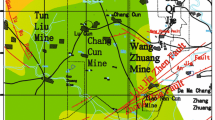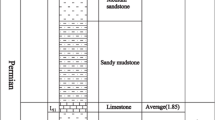Abstract
This paper presents a way to evaluate the degree of fault complexity in coal mines using the geographic information system (GIS) and fractal theory. First, the factors that affect the degree of complexity of coal mine faults are determined. Then, an analytic hierarchy process model is used to calculate the factor weighting, and an information entropy model is used to improve the weight information. Based on the local weighted linear combination, a fault complexity index is calculated. The proposed method was validated by a case study at the Chensilou coal mine in Henan Province, China. The result indicates that the method is robust; the degree of fault complexity was quantified and categorized. The fault complexity in the studied area consists of simple and moderate faults and the water yield was found to increase with the complexity index, indicating an increased risk of water inrush.
Zusammenfassung
Die Arbeit beschreibt eine Methode zur Bewertung des Komplexitätsgrads von Störungen in Kohlegruben unter Verwendung eines Geographischen Informationssystems (GIS) und der Fraktaltheorie. In einem ersten Schritt werden die für die Störungskomplexität maßgeblichen Faktoren bestimmt. Anschließend wird ein analytisch-hierarchisches Prozessmodell zur Berechnung der Wichtung der einzelnen Faktoren eingesetzt, wobei ein Informations-Entropie-Modell zur Verbesserung der Wichtungsinformation dient. Auf Basis der lokalen gewichteten Linearkombination wird ein Störungskomplexitätsindex bestimmt. Die vorgeschlagene Methode wurde im Rahmen einer Fallstudie in der chinesischen Kohlengrube von Chensilou, Provinz Henan, validiert. Im Ergebnis zeigt sich, dass die Methode robust ist; der Störungskomplexitätsgrad wurde quantifiziert und kategorisiert. Die Störungskomplexität in dem untersuchten Gebiet besteht aus einfachen und mittelgradigen Störungen. Die Wasserergiebigkeit steigt mit dem Komplexitätsindex und weist damit auf ein sich erhöhendes Risiko für Wassereinbrüche hin.
Resumen
Este artículo presenta una forma de evaluar el grado de complejidad de las fallas en las minas de carbón utilizando el sistema de información geográfica (GIS) y la teoría fractal. Primero, se determinan los factores que afectan el grado de complejidad de las fallas de las minas de carbón. Luego, se utiliza un modelo de proceso de jerarquía analítica para calcular la ponderación de los factores y se utiliza un modelo de entropía de la información para mejorar la información del peso. Con base en la combinación lineal ponderada local, se calcula un índice de complejidad de fallas. El método propuesto fue validado por un estudio de caso en la mina de carbón Chensilou en la provincia de Henan, China. El resultado indica que el método es robusto; el grado de complejidad de la falla fue cuantificado y categorizado. La complejidad de la falla en el área estudiada consiste en fallas simples y moderadas y se encontró que la carga hídrica aumenta con el índice de complejidad lo que indica un mayor riesgo de entrada de agua.
抽象
本文提出了一种基于GIS与分形理论的矿井断层构造复杂程度的评价方法。首先,确定了断层构造复杂程度的影响因素。然后,应用层次分析模型计算因素的权重,并通过信息熵模型对权重进行改进。基于局部的加权线性组合方法,计算了断层构造复杂指数。通过中国河南陈四楼矿的工程案例验证了方法的可行性。结果表明,该方法具有较强的鲁棒性;断层构造复杂程度被量化和分类。研究区断层构造复杂度为简单和中等,其涌水量随复杂指数的增加而增加,同时突水危险性增加。





Similar content being viewed by others
Explore related subjects
Discover the latest articles and news from researchers in related subjects, suggested using machine learning.References
Adib A, Afzal P, Ilani SM, Aliyari F (2017) Determination of the relationship between major fault and zinc mineralization using fractal modeling in the Behabad fault zone, central Iran. J Afr Earth Sci 134:308–319
Aviles CA, Scholz CH, Boatwright J (1987) Fractal analysis applied to characteristic segments of the San Andreas fault. J Geophys Res Sol Ea 92(B1):331–344
Babanouri N, Nasab SK, Sarafrazi S (2013) A hybrid particle swarm optimization and multi-layer perceptron algorithm for bivariate fractal analysis of rock fractures roughness. Int J Rock Mech Min Sci 60:66–74
Ben-Zion Y, Sammis CG (2003) Characterization of fault zones. In: Seismic Motion, Lithospheric Structures, Earthquake and Volcanic Sources: the Keiiti Aki Volume. Birkhäuser, Basel, pp 677–715
Carpinteri A, Paggi M (2008) Size scale effects on strength, friction and fracture energy of faults: a unified interpretation according to fractal geometry. Rock Mech Rock Eng 41(5):735–746
Carpinteri A, Paggi M (2009) A fractal interpretation of size scale effects on strength, friction and fracture energy of faults. Chaos Soliton Fract 39(2):540–546
Carter B, Rinner C (2014) Locally weighted linear combination in a vector geographic information system. J Geograph Syst 16(3):343–361
Chakraborty S, Banik D (2006) Design of a material handling equipment selection model using analytic hierarchy process. Int J Adv Manuf Tech 28(11):1237–1245
Chen JF, Zhu ZJ, Yan CD (1999) Fractal dimension description of fault density in a coal mine. Coal Geol Chin (3):8–10 (In Chinese)
Demirel N, Yücenur GN, Demirel T, Muşdal H (2012) Risk-based evaluation of Turkish agricultural strategies using fuzzy AHP and fuzzy ANP. Human Ecolog Risk Assess Int J 18(3):685–702
Duan LH, Ran DL (2013) Nonlinear analysis of coal mine water in-flows and fault structure. Chin Coal 9:32–35 (In Chinese)
Eastman JR (1999) Multi criteria evaluation and GIS. Geogr Inf Syst 1(1):493–502
Guarnieri P (2002) Regional strain derived from fractal analysis applied to strike slip fault systems in NW Sicily. Chaos Soliton Fract 14(1):71–76
Han J, Shi LQ, Yu XG, Wei JC, Li SC (2009) Mechanism of mine water inrush through a fault from the floor. Int J Min Sci Tech 19(3):276–281
Hirata T (1989) Fractal dimension of fault systems in Japan: fractal structure in rock fracture geometry at various scales. Pure Appl Geophys 131(1):157–170
Hossain MS, Kruhl JH (2015) Fractal geometry based quantification of shock-induced rock fragmentation in and around an impact crater. Pure Appl Geophys 172(7):2009–2023
Jenks GF (1963) Generalization in statistical mapping. Ann Assoc Am Geogr 53(1):15–26
Jiang H, Eastman JR (2000) Application of fuzzy measures in multi-criteria evaluation in GIS. Int J Geogr Inf Sci 14(2):173–184
Kato N, Lei X (2001) Interaction of parallel strike slip faults and a characteristic distance in the spatial distribution of active faults. Geophys J Int 144(1):157–164
Li J, Feng Q, Guo QL (2008) Fractal study of sustainable proportions of natural and artificial oases. Environ Geol 55(7):1389–1396
Li LC, Yang TH, Liang ZZ, Zhu WC, Tang CN (2011) Numerical investigation of groundwater outbursts near faults in underground coal mines. Int J Coal Geol 85(3–4):276–288
Makropoulos CK, Butler D (2006) Spatial ordered weighted averaging: incorporating spatially variable attitude towards risk in spatial multi-criteria decision-making. Environ Modell Softw 21(1):69–84
Malczewski J (2000) On the use of weighted linear combination method in GIS: common and best practice approaches. Trans GIS 4(1):5–22
Malczewski J (2006) GIS based multicriteria decision analysis: a survey of the literature. Int J Geogr Info Sci 20(7):703–726
Malczewski J (2011) Local weighted linear combination. Trans GIS 15(4):439–455
Mandelbrot BB (1979) Fractals: form, chance and dimension. WH Freeman and Co., San Francisco
Mandelbrot BB (1983) The fractal geometry of nature. W. H. Freeman, New York City
Miao XX, Liu WQ, Chen ZQ (2004) Dynamics of systems of seepage flow in surrounding rock affected by mining. Science Press, Beijing (In Chinese)
Network of coal mine safety production in China (2018) Accident management. http://www.mkaq.org/sggl/. Accessed 7 May 2018
Öncel AO, Main I, Alptekin Ö, Cowie P (1996) Spatial variations of the fractal properties of seismicity in the Anatolian fault zones. Tectonophysics 257(2–4):189–202
Pérez López R, Paredes C, Muñoz Martín A (2005) Relationship between the fractal dimension anisotropy of the spatial faults distribution and the paleostress fields on a Variscan granitic massif (Central Spain): the F parameter. J Struct Geol 27(4):663–677
Saaty TL (1980) The analytic hierarchy process. McGraw Hill, New York City
San Cristóbal JR (2011) Multi criteria decision making in the selection of a renewable energy project in Spain: the Vikor method. Renew Energ 36(2):498–502
Sengupta P, Nath SK, Thingbaijam KKS, Mistri S (2011) Fractal analysis of major faults in India on a regional scale. J Geol Soc India 78(3):226
State Administration of Coal Mine Safety (2014) Regulations of geological work for coalmines. Coal Industry Press, Beijing (In Chinese)
Sukmono S, Zen MT, Kadir WGA, Hendrajaya L, Santoso D, Dubois J (1996) Fractal geometry of the Sumatra active fault system and its geodynamical implications. J Geodyn 22(1–2):1–9
Uyan M (2013) GIS-based solar farms site selection using analytic hierarchy process (AHP) in Karapinar region, Konya or Turkey. Renew Sust Energ Rev 28:11–17
Wang Y, Yang WF, Li M, Liu X (2012) Risk assessment of floor water inrush in coal mines based on secondary fuzzy comprehensive evaluation. Int J Rock Mech Min Sci 52(6):50–55
Wang X, Wang T, Wang Q, Liu X, Li R, Liu B (2017) Evaluation of floor water inrush based on fractal theory and an improved analytic hierarchy process. Mine Water Environ 36(1):87–95
Wu Q, Zhou WF (2008) Prediction of groundwater inrush into coal mines from aquifers underlying the coal seams in China: vulnerability index method and its construction. Environ Geol 56(2):245–254
Wu Q, Wang M, Wu X (2004) Investigations of groundwater bursting into coal mine seam floors from fault zones. Int J Rock Mech Min Sci 41(4):557–571
Xu D (2011) Advances in the research on mechanisms of the groundwater inrush caused by the fault reactivation in coalmines. Proc Eng 26:824–831
Yang BB, Sui WH, Duan LH (2017) Risk assessment of water inrush in an underground coal mine based on GIS and fuzzy set theory. Mine Water Environ 36(4):617–627
Zhao J, Chen S, Zuo R, Carranza EJM (2011) Mapping complexity of spatial distribution of faults using fractal and multifractal models: vectoring towards exploration targets. Comput Geosci 37(12):1958–1966
Zou X, Li D (2008) A multidisciplinary GIS-based approach for the potential evaluation of land consolidation projects: a model and its application. In: Proceedings of WSEAS International Conf on Mathematics and Computers in Science and Engineering (No. 7), World Scientific and Engineering Academy and Soc
Acknowledgements
The authors acknowledge financial support from the National Key R&D Program of China under Grant 2017YFC0804101. We also thank the Yongcheng Coal and Electricity Holding Group Co. Ltd for providing data support.
Author information
Authors and Affiliations
Corresponding author
Electronic supplementary material
Below is the link to the electronic supplementary material.
Rights and permissions
About this article
Cite this article
Yang, B., Yuan, J., Duan, L. et al. Using GIS and Fractal Theory to Evaluate Degree of Fault Complexity and Water Yield. Mine Water Environ 38, 261–267 (2019). https://doi.org/10.1007/s10230-018-0563-8
Received:
Accepted:
Published:
Issue Date:
DOI: https://doi.org/10.1007/s10230-018-0563-8




